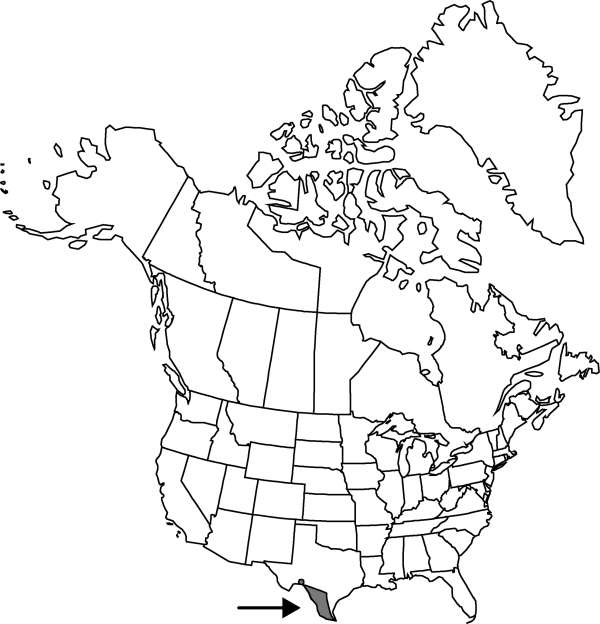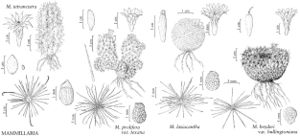Mammillaria prolifera var. texana
Cacti, 16. 1937.
Plants branched; branches 5–20+. Roots fibrous, upper portion not enlarged. Stems spheric to cylindric-clavate, 3–9 × 1.2–5 cm, somewhat flaccid; tubercles 7–10 × 3.4–5 mm; axils mostly bearing sparse white hairs and slender bristles equaling or exceeding tubercle length; cortex and pith not mucilaginous; latex absent. Spines 30–50 per areole, white to yellow or reddish sometimes tipped dark, puberulent; radial spines 25–40 per areole, white to pale yellow, hairlike, 3–12 × 0.01–0.02 mm, soft, strongly contrasting with relatively rigid, colored central spines; central spines 5–12 per areole, spreading in all directions, straight, 4–9 × 0.11–0.17 mm, puberulent; subcentral spines 0. Flowers 1–1.8 × 0.8–1.7 cm; outermost tepal margins entire; inner tepals whitish to creamy yellowish with pinkish or greenish brown midstripes, 6.5–8 × 2–3 mm; stigma lobes whitish to yellowish, 1.5–4 mm. Fruits bright red, obovoid to clavate-cylindric, 8–20 × 4–5 mm, juicy only in fruit walls; floral remnant persistent. Seeds black, 1–1.3 × 1–1.3 mm, pitted; testa hard; anticlinal cell walls weakly undulate to almost straight; interstices wider than pit diameters; pits bowl-shaped. 2n = 44.
Phenology: Flowering spring (Mar–May).
Habitat: Tamaulipan thorn scrub, oak-juniper woodlands, gravel, limestone crevices, or litter beneath vegetation, cliffs, hills, valleys, plains
Elevation: 0-600 m
Distribution

Tex., Mexico (Coahuila, Nuevo León, San Luis Potosí, Tamaulipas).
Discussion
North of Mexico, the hairlike radial spines of Mammillaria prolifera provide an instant means of identifying this species, even without reproductive material. The species is diploid and tetraploid in Mexico, tetraploid in Texas, and mostly hexaploid in the Greater Antilles with tetraploids persisting at least on Hispaniola (M. A. T. Johnson 1978). Spine color and strength of spines form the basis of taxonomic distinction in M. prolifera in the broad sense (D. R. Hunt 1987).
Selected References
None.
